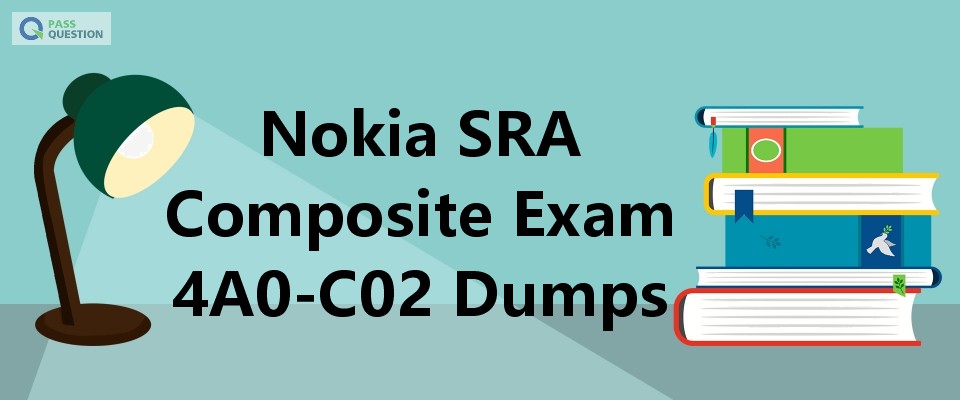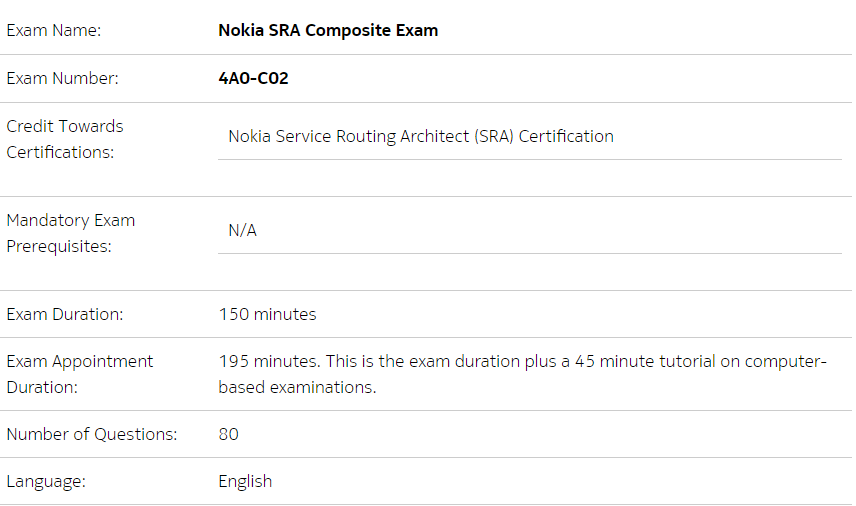Nokia SRA Composite Exam 4A0-C02 Dumps
Are you preparing for 4A0-C02 Nokia SRA Composite Exam? To help you prepare 4A0-C02 exam, PassQuestion recommends you that you should have the sound knowledge and experience about 4A0-C02 exam. PassQuestion offers the latest Nokia SRA Composite Exam 4A0-C02 Dumps which cover the real 4A0-C02 exam topics to ensure you pass 4A0-C02 exam successfully. With the help of the PassQuestion Nokia SRA Composite Exam 4A0-C02 Dumps and guidance of 4A0-C02 certification exam, you can pass your Nokia Service Routing Architect (SRA) Certification 4A0-C02 exam in your first attempt.

4A0-C02 Exam Information - Nokia SRA Composite Exam

The SRA composite exam combines the four required individual exams for SRA certification into a single, integrated exam. The four individual exams are:
Nokia Border Gateway Protocol (Exam #4A0-102)
Nokia Virtual Private LAN Services (Exam #4A0-105)
Nokia Virtual Private Routed Networks (Exam #4A0-106)
Nokia Quality of Service (Exam #4A0-107)
Candidates will have the option to write the single SRA composite exam or write the four individual exams outlined above.
4A0-C02 Exam Topics
The list below provides broad guidelines for the type of content that may be included in the exam. Other material not described here may be incorporated into the exam.
BGP
Describe the basic Internet Architecture and related elements
Describe the role of BGP in service provider networks
Demonstrate a sound understanding of BGP mechanics and the role of BGP attributes
Explain the interaction between BGP and interior gatewayprotocol (IGP)
Plan and implement a basic BGP network using Nokia SR OS
Successfully configure, monitor and troubleshoot a network of multiple BGP peers
Implement BGP policies in an Nokia environment
Verify and troubleshoot the results of the policies configurations
Scale iBGP by deploying confederations or route reflections
Configure and verify BGP confederations
Configure and verify BGP route reflections
Describe the effect of using advertise-external feature on BGP route propagation
Explain BGP add-paths feature
Describe the operation of BGP fast reroute
Configure and verify BGP advertise-external, add-paths, and FRR on Nokia SR
VPLS
Review Ethernet technology, MPLS features and the terminology of SAPs and SDPs in services
Using the basic components of services (SAPs and SDPs), create a simple VPLS
Describe the advantages of a VPLS and configure a VPLS service
Explain the impacts of MTU on a distributed VPLS service
Describe the VPLS FDB and list the tools required to maintain the VPLS FDB
Manage a VPLS infrastructure, and troubleshoot and repair a misconfigured VPLS
Describe the purpose and operation of policy-based forwarding
Implement loop control mechanisms such as rapid spanning tree in a VPLS environment
Define management VPLS (M-VPLS) and how it can be used with STP to provide redundancy and load balancing
Describe the use of LAG and MC-LAG in providing resiliency in a VPLS configuration
Describe the use of active and standby pseudowires to achieve redundancy instead of STP
Explain the key scalability concerns in large VPLS deployments
Explain the concept of a hierarchical VPLS and its benefits for large VPLS networks
Explain the concept of PBB (provider backbone bridging) and how it resolves the problem of MAC explosion when connecting to multiple bridging sites
VPRN
Describe the operation of the basic VPRN architecture
Explain how the VPRN routing information is distributed among Provider Edge (PE) routers, through the use of Multiprotocol BGP extensions
Identify the cause of BGP loops in a VPRN environment
Implement loop prevention in VPRN using multiple techniques
Configure, verify, and troubleshoot VPRN
Describe the operation of advanced VPRN topologies and services
Understand full, hub and spoke, and extranet VPRN topologies
Describe the operation of providing Internet access using various techniques
Understand the operation of Inter-AS VPRN model A, model B and model C
Configure, verify and troubleshoot Inter-AS VPRNs
Describe the carrier supporting carrier (CSC) VPN model
Understand the exchange of routes and the data path in CSC
Configure, verify and troubleshoot a CSC VPRN
QoS
List the business drivers for QoS
Describe traffic classification, queuing, scheduling, and marking as they pertain to QoS including, rate limiting, resource allocation and congestion management
Configure various QoS-related policies on the Nokia 7750 SR to provide differentiated services confirming to SLAs
List the criteria that can be used to classify and mark packets at service and network ingress/egress to support optimal use of networking resources
State the purpose of the queuing and scheduling parameters PIR, CIR, MBS, CBS, High Priority only, queue type, queue mode and adaptation rule
State the purpose of Weighted Random Early Detection (WRED) to increase average utilization of networking resources as they approach congestion
State the need for a multi-tiered scheduling (HQoS) architecture on SAP ingress and egress
Apply QoS concepts to the applicable service (virtual private wire service [VPWS], virtual private LAN service [VPLS], virtual private routed network [VPRN], or Internet enhanced service [IES])
Describe the need for egress port scheduling and its operation in conjunction with an HQoS scheduler
Explain how standalone policers enforce the configured rate, CIR, MBS, CBS and HPO to color packets
Explain how Class Fair Hierarchical Policing (CFHP ) supports four layers of hierarchy, and dynamically enforces rates, using the priority, and weights assigned to child policers and arbiters
Design, configure, apply, and predict the expected behavior of a CFHP policy
Explain Ethernet queue groups and how they are typically used on access ingress, access egress, network ingress, and network egress
- TOP 50 Exam Questions
-
Exam
All copyrights reserved 2025 PassQuestion NETWORK CO.,LIMITED. All Rights Reserved.

